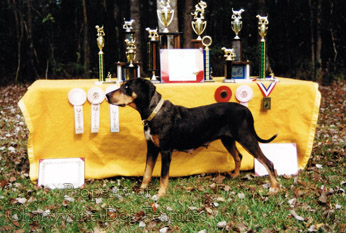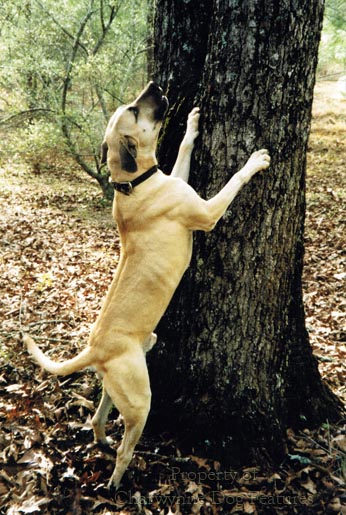468 US Cur Hunting Dogs
NEW KINDS OF SOUTHERN HOUND
by David Hancock
.jpg) We no longer have a southern hound; it was long ago subsumed into our surviving scenthound breeds. Dalziel wrote, rather charmingly in 1888: "In the course of evolution which has been going on, the old Southern Hound has disappeared, with many other types, unsuited to new times and conditions, but their good qualities have been preserved in new combinations of excellencies." But the old stock was tapped into elsewhere too. In his Hounds and Hunting through the Ages (New York, 1928), the great American MFH, Joseph Thomas recorded: "In 1650, Robert Brooke sailed for the Crown colony in America in his own ship, taking with him his family...and his pack of hounds...George Washington, who had kept hounds from his youth...was, with British officers and residents of New York, a subscriber to an importation from England, in 1770, of hounds, horses and servants." American sportsmen have long benefited from the blood of our hounds, leading to the development of some outstanding hunting dogs of their own, especially the southern hounds.
We no longer have a southern hound; it was long ago subsumed into our surviving scenthound breeds. Dalziel wrote, rather charmingly in 1888: "In the course of evolution which has been going on, the old Southern Hound has disappeared, with many other types, unsuited to new times and conditions, but their good qualities have been preserved in new combinations of excellencies." But the old stock was tapped into elsewhere too. In his Hounds and Hunting through the Ages (New York, 1928), the great American MFH, Joseph Thomas recorded: "In 1650, Robert Brooke sailed for the Crown colony in America in his own ship, taking with him his family...and his pack of hounds...George Washington, who had kept hounds from his youth...was, with British officers and residents of New York, a subscriber to an importation from England, in 1770, of hounds, horses and servants." American sportsmen have long benefited from the blood of our hounds, leading to the development of some outstanding hunting dogs of their own, especially the southern hounds. 
Very much developed in the United States, in north-east Louisiana, is the rather dramatically named Catahoula Leopard or Hog Dog, Catahoula meaning beautiful clear water. A muscular, Dalmatian-sized hound, but used extensively as a herding dog, they are usually black merle, with their black patches earning them their breed title. They can also be solid-coloured: black, blue, red and yellow-tan, the coat colours long associated with the mastiff breeds. The distinctive black merle is also found in Great Danes and the Norwegian Dunker Hound. Possessing the classic phenotype of the running mastiffs, they are versatile hunting and herding dogs, able to hot track lost stock, bring it to bay when found and then 'hold it'. This is a difficult task with defiant semi-wild cattle and wilful half-wild hogs. These dogs are often used in teams, with specialist roles: leading, herding or rounding up and driving in the destined direction. They combine this testing task with that of hunting dogs, where they can exercise their 'par force' hunting skills, using sight and scent, their great stamina and immense determination.
Skip and Vicki Loudenslager of the Cottonwood Kennels, Lake Odessa, Michigan, have had Catahoulas for eleven years and bred nine litters in that time. They have the first two UKC champions, the first three grand champions and the first UKC agility champion on record. So far, they have produced 13 UKC champions. Their red dog Trace came 2nd out of 25 dogs at the National Association of Louisiana Catahoula's (NALC) show. Skip hunts them on raccoon and is anxious to keep the working instincts of the breed alive. He tells me that his dogs hunt more as sighthounds, do not run cold tracks, bay like a scenthound or have the latter's temperament. He stresses that his dogs will cease tracking once they see their quarry, the classic once-favoured technique of hounds hunting 'at force'.
Don Abney of Abita Springs, Louisiana, the author of a book on the breed, is a NALC certified breeder (and trainer of all breeds), using his Catahoulas across a range of skills. This is an extremely versatile breed, able to hunt, track, herd and compete in agility trials. Registered as the Louisiana Catahoula Leopard Dog with the NALC, the UKC (United Kennel Club), the ARBA (American Rare Breed Association) and the SKC (States Kennel Club), but known informally as the Catahoula Cur, the breed is listed in the Herding Group for show ring purposes. That may recognise their pastoral skills but is scant reward for their sheer versatility.
Some researchers have linked this breed with dogs brought to the Americas by Spanish colonists, to be subsequently acquired by Indians and later by settlers. There are theories too of the introduction of the blood of herding dogs brought out by French immigrants, with the harlequin coat (what the French call 'gris avec taches noires [danoises]') of the Beauceron, perhaps in mind. But there is a genetic difference between harlequin and merle. Smoother-coated, drop-eared dogs like the Norwegian Dunker Hound would be a more likely foreign source. Interestingly, my namesake, the highly successful English lurcher breeder produces collie/greyhound lurchers with this type of physique and striking coat colour and they are superbly efficient hunting dogs. As Sullivan wrote a century ago: "Form follows Function". Known affectionately as 'cats', used successfully as coonhounds, these Leopard Dogs have been described as 'walking sledgehammers' because of their forcefulness and sheer physical power; they are today's equivalents of medieval par force hounds.
In a previous article on lion-hunting I described how the American hunter Shelley used hounds from his country in his 'bobbery pack' of lion-hunting dogs in Africa in the 1920s. In his 'Jaguar Hunting in the Mato Grosso' of 1976, de Almeida wrote: "...good dogs are essential to a successful hunt. And good jaguar-dogs are the hardest thing to come by in Mato-Grosso...We arranged for Bert to send down to us six hounds of the Plott breed, which were trained to hunt bear in the forests of Washington State, near Seattle. This race of hound is famed for its courage, having been bred over the years strictly for hunting big game...The Plott breed is an overall brindle colour, but varying from orange in some dogs to almost black in others." Once again, a famous big game hunter is singing the praises of brindle hunting dogs, brindle running mastiffs.
Known affectionately as 'Ole Yeller' because of its coat colour, the Black Mouth Cur or Southern Cur, of the United States, has all the uses and appearance of a running mastiff. Weighing up to 95lbs, with a height at the shoulder of up to 25 inches, these versatile hunting dogs have been used on quarry ranging from squirrel and raccoon to bear and boar. Famous for their long loping stride, great stamina and even more impressive gameness, they hunt and catch their prey, never flinching from closing with fearsome adversary like boar. They can work stock too as can so many of the mastiff-like breeds.
Short-haired, with a coat varying from light red, through golden yellow to fawn or sandy yellow/tan, they usually feature a black mask and muzzle and sometimes have white toes or a small white spot on their chest. They resemble the Rhodesian Ridgeback, without the ridge. They are silent on the trail, but give a characteristic 'yodel' as they close in on their prey. With a strongly developed desire to please their masters and great hunting skills, they have proved their worth over the years on many remote farms. Such dogs deserve more recognition, especially when you consider that given to purely ornamental breeds which never worked to help man survive in testing times.
If breeds like these American ones, and indeed the Broholmer of Denmark, the Rhodesian Ridgeback, the Dogo Argentino and the Great Dane from Germany are to thrive, they must be bred in the mould of their hunting field ancestors. The powerful strong-headed running mastiffs may no longer have a role in Europe as big game hunters, but they are a distinctive element in canine heritage as well as fine breeds in their own right. Soon there may well be no place for determined strongly-made hard-running hounds in Britain and one can only hope that, just as our packhounds were exported to America in the 17th and 18th centuries, valuable genes at least can be perpetuated abroad. In the past, we have ourselves imported tiger-dogs from Ulm (the Great Dane) and lion-dogs from Africa (the ridgeback), but I do hope that we never attempt to import the leopard-dogs of Louisiana. They are highly-bred highly-competent hunting dogs with a strong desire to exercise their skills; they would hate it here.